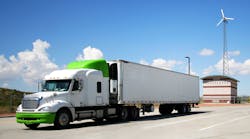It seems as if the trucking industry is in another transformative period. This time the transformation is to the more sustainable movement of goods. A combination of both regulatory and social pressures is causing fleets to examine the types of equipment they are running as well as their internal operations.
I am hearing that in some requests for proposals, shippers are asking questions about fleets’ efforts to reduce their carbon footprint and improve their fuel efficiency. In addition, we now have the first-ever blueprint to decarbonize transportation that is a strategy for reducing greenhouse gas emissions from trucking by 2050.
On top of that, it is very likely that there will be one—if not two—increases in the upfront cost of diesel-powered equipment as truck makers make changes to the engine in order to meet upcoming Environmental Protection Agency regulations for further emissions reductions.
There are a variety of options available to fleets when it comes to cleaner powertrain options. We need to remember that this transformation to a cleaner transportation future will not take place overnight, but that does not mean we should just continue with the status quo.
See also: Take the fork in the road to zero
I am not suggesting fleets rush out and purchase electric vehicles, hydrogen fuel cell vehicles, or other alternative fuel vehicles. For one thing, manufacturers of those types of vehicles are subjected to the same supply chain issues as manufacturers of diesel-powered vehicles. We need to remember that currently there is not a single alternative to diesel that will work in all duty cycles.
However, fleets do need to begin looking at what the alternatives are and how powertrain options other than diesel fit into their operations, especially because changes may need to be made to the fleet’s depot to accommodate these alternative-fueled vehicles. Those infrastructure changes can take time to complete so it is important that planning takes place in enough time.
See also: Charging infrastructure holds back EV truck production, deployment
In addition to reviewing powertrain options, fleets should perform an asset utilization analysis to make sure they are getting the most out of the assets they do own. It might also be wise to look at the type of equipment that is owned to see if your vehicle mix still makes sense for the types of loads you carry and distances you travel. For example, if your fleet has moved to more regional haul in an effort to retain drivers, do you need to operate sleeper tractors? If you are doing more last mile deliveries, can you switch to smaller vehicles?
You also should look at your routing. Is your routing as efficient as it can be? When was the last time you did a routing analysis? It might be worth your time to take a fresh look at routing to see if there are changes you can make to optimize it. Also look at empty backhauls and see if there are ways to minimize them in order to increase efficiency.
We are indeed moving into a cleaner transportation future and there are multiple actions you can take to move into that future.
Gino Fontana, CTP, is COO and EVP at Transervice Logistics Inc. Prior to this, he was VP of operations at Berkeley Division and Puerto Rico. He has more than 35 years of experience in the transportation and logistics industry with both operational and sales experience.



